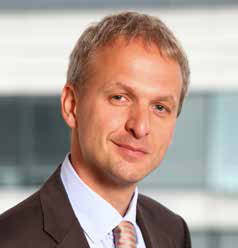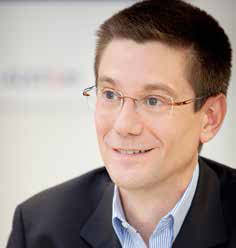You have all these stability issues because of the intermittent nature of renewable energy and the only
way around that is to interconnect so France has to double its interconnections with
neighboring countries in the next five years. That’s a big part of its plan.”
He continued. “We’re an American business masquerading as a French company,”
the Harvard MBA grad said. “All our software development is actually in Redmond,
[Washington State] where a team of roughly 400-450 employees work. It’s all our development
for network management, energy management, the distribution management,
demand response now.” Alstom Philadelphia is home to the company’s US grid headquarters
and its Power Electronics Center of Expertise for Static Var Compensator
(SVC). The Power Electronics Philadelphia unit provides support and enhancements to
Flexible AC Transmission Systems (FACTS) projects in the Americas. Alstom Grid has
three other locations in the US and Canada for a total of 35 manufacturing plants globally,
30 grid projects are under development worldwide and is a global leader in missioncritical
software solutions with a market share of 13.7%.
|

Grégoire Poux-Guillaume
President,
Alstom Grid Sector
This interview was conducted on February 12th
in the sun-kissed French Riviera city of Nice,
on the rocky coast of the Mediterranean. |

Patrick Plas,
Senior Vice President
Grid Power Electronics and Automation
Alstom Grid |
Patrick Plas said in his opening
remarks that “Alstom envisions that the
smart grid market has the potential to
grow to €51 billion by 2020, up from the
present €29 billion creating 100,000 new
highly skilled engineering jobs and another
300,000 indirect jobs.” He defined the
smart grid as an intelligent electrical network
with two-way flow of energy and realtime
information between power generation,
grid operators and consumers. Its
three-level architecture includes traditional
grid equipment (substations, lines, etc.)
to transmit electricity at low, medium and
high voltage; automated systems that interconnect
renewable energy sources, storage
solutions and consumers to manage
the flow of electricity across the grid and
control centers using software solutions to
manage transactions, balance supply and demand and interconnect all networks.
In the next ten years, energy demand is expected to grow by 22 percent in the US
and Europe, 78 percent in Latin America and by triple digits in the rest of the world.
Plas, using the smart grid model, sees a twenty percent savings achievable by demand
side management in the investment needed for generation and infrastructure; by load
shedding, the smart grid manages peak demands and blackout risks; smart-grid solutions
can balance supply in real time transparency balancing electricity from renewables
and the smart grid will make consumers into prosumers to control costs and volatility
on real time information and incentive offers. |
“Peer to peer exchange does not mean that the
utility will not exist. The utility will exist and grid operation will be a fundamental element
of the smart grid, but in a slightly different model,” Schmitt underscored. The
first two years have been spent in design of the project and now we are recruiting customers,”
he said in conclusion.
The sun-kissed French Riviera attracts large summer populations straining the supply
of electricity. Alstom, its partners, and the Nice Town Council responded by building a
micro grid, optimizing energy production from solar panels. The town of Carros, a 20 minute bus ride from Nice, was chosen as the test site because its location on the periphery of
France’s transmission grid increases the risk of outages, along with its seasonal sunshine
and diverse commercial and residential population. The NICE GRID draws on three key
factors to balance supply and demand: next day forecasts for solar energy production compared
with demand; battery storage to maintain voltage and frequency across the grid offsetting
any intermittency in solar energy and consumption peaks and incentivizing residential
and industrial customers to manage their consumption.
Christophe Arnoult, Project Director of Smart Grids at Electricite Reseau
Distribution France told World-Gen that, “Linky is the name of the smart meter program
ERDF launched. Linky will be installed in Carros by the end of 2014. These customers
are the basis for the recruitment of participants in the pilot as they will represent 95% of
the customers whose home electric installation is suitable for the NICE GRID pilot. Out
of these 2600, the project will seek to recruit several hundred participants for the load
management program. The linky meter is used both ways: from the customer’s premises
up to the NICE GRID central computer to transmit the load curves and from the
NICE GRID computer down to the customer premises (always through an aggregator)
for the control of the flexibilities (manageable load) that are activated by the system.”
DATA MINING
Once data has been collected, it must be immediately processed into actionable
information (data mining) for the grid operator to balance the complex system. Control
room IT systems are configured to cover the full range of mission-critical power grid
issues, such as congestion analysis, dynamic stability, anticipation of contingencies,
snapshots of estimated output from renewable sources, forecasts and outage management.
Operators have the intelligence for electricity flow (quality, measurements,
oscillations, metering, etc.) across the lines, substations and equipment.
NETWORK MANAGEMENT
Marc Delprat is in charge of Alstom’s small pilot programs within the network management
solutions. “Network management solutions (NEM) are like the brains behind the
grid,” he said during his presentation in the NICE GRID Showroom in Carros.
In the NICE GRID, NEM handles load reduction from demand response and
storage. It collects solar production and load forecasts and imports regional load
reduction requests, calculates local grid constraints and identifies risks of overvoltage.
It then sends power adjustment needs to the suppliers, computes an optimal schedule
of flexible solutions and activates flexible solutions to counter local and regional grid
constraints on a rotating basis. Finally, it balances the grid in islanding and manages
over voltage situations due to massive solar generation.
MAXINE™ ESTORAGE
Alstom supplied its new MaxSine™ eStorage conversion solution connecting batteries
to the high/medium voltage network, Alstom’s Davy Theophile told the journalists.
MaxSine™ eStorage is installed with a power converter and software which controls
storage facilities. The NICE GRID solar district is the only solution able to handle
megawatt-scale storage providing a connection of up to 12 MW’s.
SAFT PARTNERS
The NICE GRID project enables testing of multiple functionality associated with
electricity storage using the LI-ion batteries integrated at three grid levels: at the originating
substation, at several distribution substations and finally at the residential
level. These batteries will have different functions at every level, and can be also synchronized
to constitute a 1,5 MW load management capacity.
MaxSine™ eStorage is a modular solution comprised of a two-way power converter
that connects the direct current battery to alternating current grid, converting electricity
to be stored in the battery or dispatched to the grid and provides real-time battery
control to balance the frequency and flow of electricity while optimizing the efficiency
and service life of the system. Pike Research projects 70% of the energy storage
market will be driven by integrating renewables, reaching 10 GW’s of installed capacity
by 2020 with 20% going to North America, 30% in Europe and 50% in Asia.
FROM SMART GRID TO SMART CITY
The worldwide population is projected to reach 6.5 billion with 70 percent living in
cities by 2050. Cities cause eighty percent of CO2 emissions. Alstom and CEA-INES, the
French state owned research agency have joined teams to investigate the use of direct current
applications in smart city projects.
Smart grids offer a solution to the challenges of smart cities. Alstom defines a smart
city as a municipality or district using networked energy, transportation, communication
infrastructures to improve economic and political efficiency enables social, cultural and
urban development.
A smart grid is by definition an open communications network, giving rise to the
question of hardware and software compatibility and data standardization. Efforts are
underway in Europe and the United States to ensure interoperability. Alstom is working
to develop IEC 61850 standards on electrical substations and CIM standards on
control rooms. |